0 导语
随着世界可再生能源渗透率的不断增加,可再生能源发电技术迅猛发展。其中太阳能光伏由于具有较高的经济效率、可持续性和低污染等优势,已经成为全球日益重要的能源供应选择,但同时也带来了许多挑战。为了研究分布式光伏发电技术对电力系统稳定性的影响,本文提出了一种基于矩阵变量的大规模分布式光伏并网系统建模方法,并结合Simulink矢量仿真功能对系统小扰动稳定性进行了全面深入的分析。
Dynamic modeling and small signal stability analysis of distributed photovoltaic grid-connected system with large scale of panel level DC optimizers
Qin Wang, Wei Yao, Jiakun Fang, Xiaomeng Ai, Jinyu Wen, Xiaobo Yang, Hailian Xie, Xing Huang
期刊:Applied Energy
Abstract
The distributed maximum power point tracking (DMPPT) technologies, based on a DC optimizer (DCO) for every single photovoltaic (PV) panel, are increasingly proposed to mitigate the waste of solar energy due to the mismatch problems of PV arrays. However, the stability problem of DMPPT based distributed PV grid-connected systems that involve a large amount of DCOs remains to be further studied. Therefore, modeling, deservedly, is the basis for stability analysis. Usually the model of the PV power plant consists of hundreds or even thousands of DCOs, which results in a heavy computation burden during the simulation. To solve the modeling problem, this paper proposes a matrix variables based modeling method for the distributed PV grid-connected system. The core idea of the modeling method is to convert the complex model that contains plenty of PV-DCO generation units to an average model consisting of only two typical submodules, by constructing the block matrix formed variables. In this way, the model has the advantages of good scalability and high simulation efficiency, and can be realized by the vector simulation feature of Matlab/Simulink. Besides, it is easy to obtain the linearization results directly by using the Linearization Toolbox in Simulink, which avoids the complexity of writing programs for linearization calculation when studying the stability of large-scale systems. Based on the average model and corresponding linearization results, the key impacts on the small signal stability of the system are determined via the eigenvalue analysis method and root locus method. It is shown that the total active power output by PV array, the controller parameters of the grid-connected inverter, and the strength of the AC system are critical factors affecting the small signal stability of distributed PV grid-connected system. Different simulation results verify the effectiveness of the proposed approach.
Highlight
· A matrix variables based model is proposed for the distributed photovoltaic system.
· The photovoltaic system can be converted to a model consisting of 2 submodules.
· The proposed method improves scalability and simulation efficiency of the model.
· The model’s linearization can be easily realized for the small stability analysis.
1 项目背景
近年来,越来越多基于光伏面板级直流优化器的分布式最大功率点跟踪技术被提出用于解决局部阴影或不匹配问题。DMPPT的研究依赖于高精度、高效率的分布式光伏并网系统动态仿真模型。而通常此类光伏电站模型包含上千的直流优化器(DCO),将导致仿真过程中计算量过大的问题。针对此类建模问题,本文提出了一种基于矩阵变量的含大规模DCO的分布式光伏并网系统建模方法,同时基于所建模型对大规模此类分布式光伏并网系统的小扰动稳定性进行了分析与评估。
2 论文所解决的问题及意义
围绕包含大规模DCO的分布式光伏并网系统建模与稳定分析问题,提出了基于矩阵变量的大规模分布式光伏并网系统建模方法。该方法可结合Simulink矢量仿真的功能实现,所建模型是一个系统规模可任意配置的平均值模型,采用模块化设计方法,具有很好的可扩展性。此外,该模型还可以利用Simulink的线性化工具箱直接得到其线性化结果,避免了大规模系统稳定性分析中人工线性化计算的复杂性。
3 论文重点内容
1)集中式光伏并网系统建模
双级集中式光伏并网系统结构如图2所示。交流等值系统归算到低压侧,故略去变压器。光伏面板经Boost变换器(DCO)后接入逆变侧交流系统,其中DCO主要有两个作用:一是实现MPPT功能;二是升压,便于匹配DCO与逆变侧直流母线的电压等级。接下来将对图1中涉及到的各环节分别建模,最后整合各部分模型形成整体1×1光伏并网系统动态模型。

图1 双级集中式光伏并网系统结构
2)M×N-PV-DCO直流网络构建方法
计及传输线路和直流母线的M×N规模PV-DCO直流侧系统拓扑结构如图2,结合基尔霍夫电压、电流原理可得到M×N直流网络平均值数学模型如式(1)所示。由于最终建立的直流网络模型并非电磁暂态模型,而是将电力电子器件的动态过程进行平均化处理后的数学模型,故无法在仿真软件中像搭建物理电路模型那样直接将DCO电路输出端口通过导线串联或并联起来,实现PV-DCO发电单元串联电流和并联电压相等的约束关系。因此有必要采用合适的处理方法,使得M×N直流系统平均值模型能够正确体现PV-DCO串并联电流、电压约束。具体处理方法可参见图3-4所示。
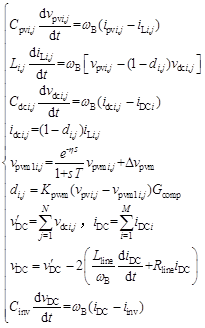
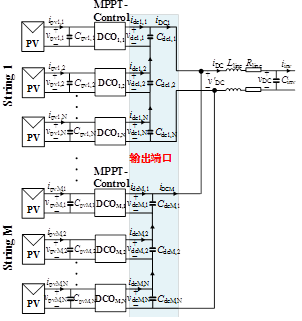
图2 M×N-PV-DCO直流网络拓扑结构

图3 输出端口串联DCO电流相等约束
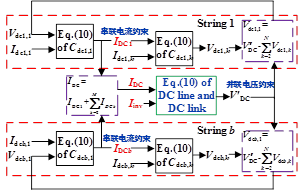
图4 输出端口并联DCO电压相等约束
3)基于矩阵变量的M×N-DMPPT光伏并网系统建模
基于前述M×N直流网络建模思路,将M×N-PV-DCO直流侧系统平均值时域方程进行拉氏变换,可得到图5所示的M×N规模直流网络建模思路,其中String2~StringM的内部结构与String1相同,各模块内电感、电容等变量名均代表其拉氏变换形式的动态方程。
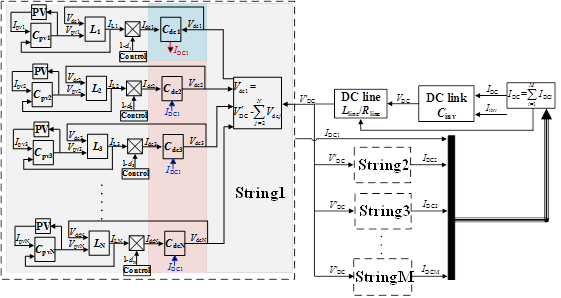
图5 M×N直流网络平均值模型(拉氏变换)搭建思路
由图5可见,对于各串联PV-DCO发电单元,其平均值数学模型的区别在于第一个DCO与其他N-1个DCO输出端口电容方程的输入量和输出量不一致。故可根据此差异将整个M×N规模的PV-DCO直流网络模型中各M×N维变量划分为两部分,即每串第一个PV面板及其DCO组成M维矩阵变量,其余N-1个PV面板及其DCO组成M×(N-1)维矩阵变量如图6所示。A代表PV-DCO直流网络中各物理量,包括各电压、电流等状态变量以及电感、电容、控制器参数等参数变量。

图6 M×N维度矩阵变量的分块形式
4)大规模分布式光伏并网系统小扰动稳定性分析
计算全系统4对主导极点涉及到的状态变量参与因子如图7所示。由计算结果可知,系统主导振荡模式主要由VSC及交流系统相关状态变量影响。后续针对各类因素,结合特征值参与因子分析法与根轨迹观察法得出相应的系统小扰动稳定性随特定因素发生改变后的变化规律,以PV-DCO阵列规模为例如图8所示。

图7 4组主导振荡模式的参与因子
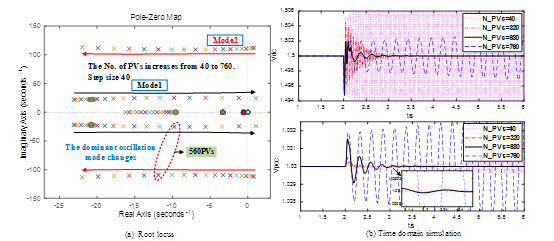
图8 根轨迹随阵列规模增加的变化情况
Conclusion
A matrix variables based modeling method for the M×N-scale distributed photovoltaic grid-connected system, containing a large number of panel level DC optimizers, is proposed to simulate dynamic characteristics and study the system’s small signal stability. The proposed modeling method aims at an average model that can be realized in Matlab/Simulink with its vector simulation function, since the M×N model can be converted to a 2×1 modular average model after partitioning the matrix variables into block matrixes. Therefore, the model has good scalability and a fast simulation speed on account of the modular design method. When the simulation time is set to 10 s, the duration of simulation in the 50×10 average model is only 2.5 min. This shows the approximate piecewise linear positive correlation with the scale of the model, which reflects the high simulation efficiency of the model to some extent. Moreover, it is easy to obtain the linearization results directly using the Linearization Toolbox in Matlab/ Simulink, which is convenient for stability analysis.
Small signal stability of the large-scale distributed PV grid-connected system has been studied using the eigenvalue analysis and root locus methods. The analysis and simulation results indicate that the total output power of the PV-DCO array, the control parameters of the voltage source converter (inverter) and the phase-lock loop, and the strength of the AC system have a great impact on the small signal stability of the system, while the topology and control parameters of DC optimizer do not. Especially with increasing the number of PV-DCO generation units or weakening the strength of the AC system, the possibility of system instability will be greatly increased. To satisfy the demand that the PV power plants can output as much power as possible, and the stability of the system will not be compromised at the same time, the optimal setting of the controller parameters can be obtained through using eigenvalue analysis and root locus method when the operating conditions and other parameters of the system have been determined. For example, a guideline to design the controllers of the voltage source converter and the phase-lock loop in the specific condition of this article can be explained as follows: (a) the PI parameters Group 2 is the best choice. (b) decrease the integral gain of the DC voltage outer loop controller and increase the proportional gain of the DC voltage outer loop controller and the phase-lock loop controller appropriately, which can observably increase the stability margin of the system.
The proposed modeling method also has the potential to be applied in the modeling and stability analysis of other distributed new energy grid-connection systems, such as large-scale offshore or onshore wind power plants and a hybrid DC microgrid that include various new energy resources and energy storage devices, which can be included in future research works.
引文信息
Qin Wang, Wei Yao, Jiakun Fang, Xiaomeng Ai, Jinyu Wen, Xiaobo Yang, Hailian Xie, Xing Huang. Dynamic Modeling and Small Signal Stability Analysis of Distributed Photovoltaic Grid-Connected System with Large Scale of Panel Level DC Optimizers[J]. Applied Energy, in press, 2019.
https://doi.org/10.1016/j.apenergy.2019.114132
作者简介:王钦(1995),男,博士研究生,研究方向为分布式光伏并网系统建模及稳定分析、电力系统规划,qin_wang@hust.deu.cn。
期刊简介:Applied Energy,一区SCI,2018年影响因子:8.4。收稿范围包括:化石能源和可再生能源的创新技术和系统,清洁能源的工业利用和家庭使用,同时包括建模和预测,以及能源政策及其对环境、社会和经济的影响。